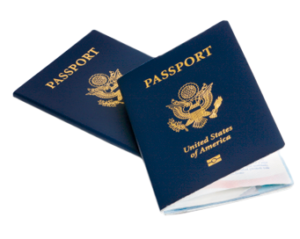This is what Passport Security looks like
Sixty different materials go into the printing of a U.S. passport. That little booklet of a thing contains up to 30 pieces of security—and you can’t see most of them. And good luck trying to get details on these security features.
 The author of an article on gizmodo.com points out that he tried to get specifics from Homeland Security, but that the “forensic lab’s experts couldn’t discuss the security.” The author then sought answers from passport and forgery experts.
The author of an article on gizmodo.com points out that he tried to get specifics from Homeland Security, but that the “forensic lab’s experts couldn’t discuss the security.” The author then sought answers from passport and forgery experts.
Holograms
When you see or hear the word “hologram,” what do you think of? Passports use holographic technology. The gizmodo.com article mentions that the biodata page of a passport probably has a see-through hologram.
It’s possible to almost forge a hologram. One way is to press metal onto it, then use the metal as a die cast to create more holograms. There’s also a device that stamps out holograms, but these days they’re difficult to get ahold of. Usually, holograms come with other security features that make forging difficult, such as special inks.
The drawback to more complex security with the passport is that some of the features can be missed in the inspection process because there are so many to remember. This creates a margin through which fake ones can pass inspection.
Ink
The gizmodo.com article talks about how the ink’s composition, and elements of the paper are part of the security. What can be done with ink to distinguish an authentic passport from a forged one? Some inks dissolve when they’re tinkered with. Some change color when cooled or heated. Some contain a design that’s visible only under UV light.
The paper, too, may contain unique fibers such as fluorescent ones. There are many other secrets that a forger could never know (though this article is obviously revealing some of them, but even then, this doesn’t mean the forger would necessarily be able to figure out how to duplicate these features).
Text one-seventh the width of a red blood cell
“Nanoprinting” is used for the passport: Text may be as small as one micron. Talk about a tiny font size. The best forgers can’t touch this. Another way to foil a forgery attempt is to deliberately create an anomaly in the text, such as a slightly raised letter.
The gizmodo.com article says that the most troublesome part of a passport to duplicate is the font. From a macroperspective, the typeface may seem easy to duplicate, but there are hidden, deliberate features visible only under a microscope. A forger won’t be able to replicate microscopic intentional ink bleeds.
Your passport will have an electronic chip in the upper left-hand corner that contains your data, including photo. The article explains that a security researcher, showed how he could clone such a chip.
Nevertheless, when all is said and done, passport forgery exists and forgers do get away with it. And as mentioned previously, there are so many security features to look for, that inspectors can’t all remember every single one, and the very one(s) they skip may also be the ones that would show a forgery. The technology needed to duplicate a passport is sold online.
At any rate, for the most part, your passport is an extremely secure instrument. Its security technology is ever-evolving. By and large, you can use your passport with peace of mind. Hold onto it tightly. Don’t let it out of your sight. When you don’t need it make sure it’s in a safe place that you won’t forget about.
Robert Siciliano is an Identity Theft Expert to Hotspot Shield. He is the author of 99 Things You Wish You Knew Before Your Identity Was Stolen See him discussing internet and wireless security on Good Morning America. Disclosures.


























